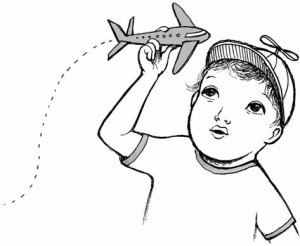
All travelers have the same goal: to find the most direct route for the best price in the shortest time. When flying with children, pay extra attention when planning that route. It can make the difference between a pleasant experience and a harrowing few hours.
There is no magic age when flying gets easier, since children mature at different rates. For me, things took a turn for the better when my younger son, B, was about four and could sit still for long periods. When he turned seven, he was old enough to carry his own bag and to keep himself entertained by reading books or listening to music. He also understood that disruptions such as delays are something we have to deal with calmly.
There are a number of practical things you can do to ensure that traveling with children goes as smoothly as possible.
* Book your flights based on when your child normally eats, sleeps, and plays. Though it may be easier said than done, have your child skip his afternoon nap to help him doze on overnight routes.
* Where possible choose direct, overnight flights for international flights more than eight hours long. Arriving in the morning will give you a slight advantage over jet lag.
* If a layover is necessary, give yourself more time than you think you’ll need between departures. This allows for flight delays and long distances between gates. Two hours is a good rule of thumb. Stay on the same carrier—or one of its partners—to simplify rebook-ing should you miss a connection. Leave even larger margins when dealing with budget airlines, which do not have co-operative agreements. One delayed flight could invalidate all your later tickets.
* Research the terminals you are flying into. If you have to change terminals, factor in an extra forty-five minutes when you’re traveling with a child.
* Before booking, consider your routing options, and fly through airports that are less busy. Airports Council International publishes data on passenger traffic. Search for Annual Traffic Data under the Data Centre link on this website. The busier the airport, the more difficult it will be to navigate with young children.
* International passengers should know where they go through customs and passport control. If you fly from North America with a domestic layover, you will not have to go through customs outbound. However, when you return, you’re required to clear customs at your first North American port. This will require a longer layover to ensure you catch your connecting flight.
* If you’re booking online, check all price quotes carefully to determine whether all the taxes and fees are listed in the final cost. Pay attention to the total duration of the trip including layovers and make sure you can wrangle your family from one gate to another.
* Most, but not all, airlines have websites that provide booking functions and sometimes you can get the best available price by booking directly with the airline.
* Meta-search engines such as Farecast and Kayak (www. kayak.com) aggregate pricing information and (in the case of Farecast) predict whether rates are rising or falling. They are not booking engines, however. If you find a suitable flight, you are redirected to the airline or booking engine where the fare was offered to complete your purchase. These sometimes expire before the transaction is completed, so move quickly!
* If you book your flights far enough in advance, you are often able to choose your seats. Airlines usually hold seats for priority customers (frequent fliers) and release them to others at a later time. Some airlines now reserve aisle seats and emergency exit rows (not suitable for children) for these same V.I.P.s or for those willing to pay extra. If youíre unable to request specific seats when you book, contact the airline closer to your departure date.
* When traveling with children, factor in the distance to the rest-rooms and whether or not you want to sit in bulkhead seats – both are bits of information that you can find on SeatGuru.
* While there are no standard rules for the pricing of childrens airfares, it is common to see discounts between the ages of two and twelve. You may also find special offers where kids fly free when accompanied by an adult who is paying full fare.
* When flying with kids, the actual seating arrangement is important. Siblings or friends may fight over who gets the window (or aisle) seat. And, if there are two adults traveling, you’ll have to decide how to arrange two adults and children across the rows. You want to ensure that your gang doesn’t annoy strangers and that you (not fellow passengers) have the pleasure of your child’s drinks spilling on your lap.
Blog Posts
Flying With Children Of All Ages
Long Haul Flights With Little Children
Practical Tips For Planning A Smooth Flying Experience With Small Children
Unaccompanied Minors
